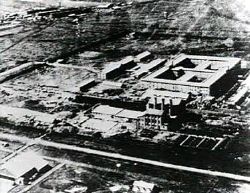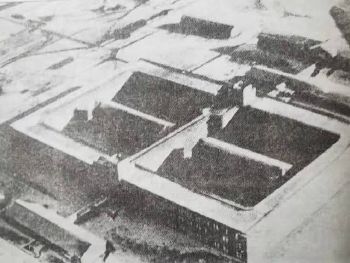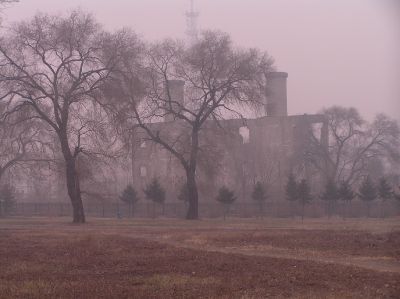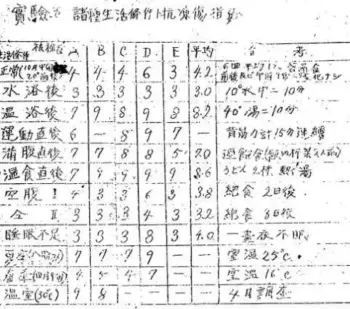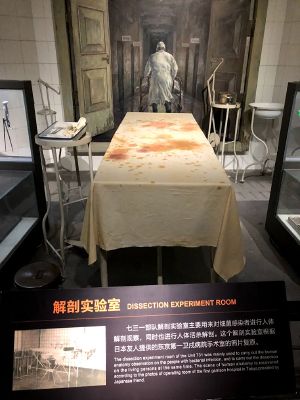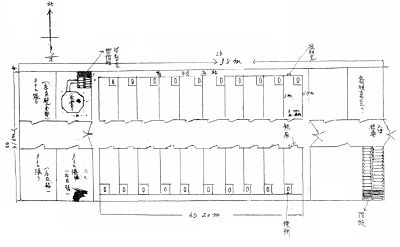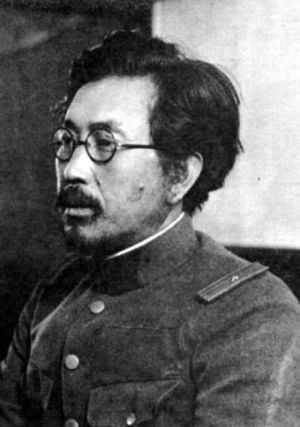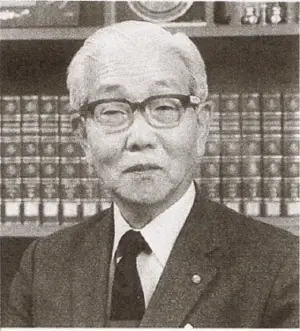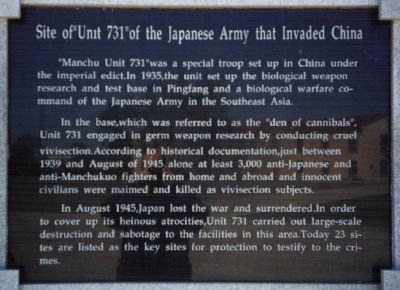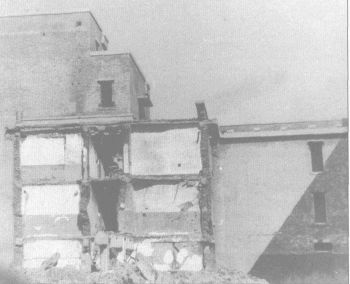Unit 731
Unit 731, short for Manshu Detachment 731, was a unit of the Imperial Japanese Army that engaged in unethical and deadly human experimentation, including testing of biological and chemical weapons on human populations, during the Second Sino-Japanese War (1937–1945) and World War II. Based in Japanese-occupied China, it was responsible for some of the most notorious war crimes committed by the armed forces of Imperial Japan, including anthrax, cholera, and bubonic plague attacks on both military and civilian populations; vivisection of men, women, children, and infants (often without anesthesia); testing of grenades and flamethrowers on people; and subjecting victims to water deprivation, low pressure, low temperature (causing frostbite), chemical agents, amputation and limb reattachment, being buried alive, and other atrocities. Because Shirō Ishii was director of Unit 731, the division has also been referred to as the Ishii Unit.
The heinous acts of torture committed by Unit 731 mirrored the inhumane experimentation conducted on prisoners by Nazi Germany. However, the aftermath of the two atrocities were very different. Many of the perpetrators of the Nazi human experimentation were tried by the United States in the Doctors' Trial, and the response to the unveiling of the Nazi crimes included the pivotal development of the Nuremberg Code and subsequently other sets of ethical standards for research with human subjects. In the case of Unit 731, most of the key participants in Unit 731, including Shirō Ishii, escaped prosecution via an agreement with the United States to provide their research findings. In addition, most of the Unit 731 crimes escaped public attention for years. Some of those responsible for Unit 731 were captured by the Soviet Union and subject to trials by that nation.
Overview
Unit 731 was active in Japanese-occupied territory in Asia, notably Manchuria. The Empire of Japan first invaded Manchuria in 1931, and in 1932 established the puppet state of Manchukuo. The formation of Unit 731 began in 1932 with the establishment of a research group in Manchukuo for chemical and biological experimentation.
Japan occupied other areas in Asia during the Second Sino-Japanese War and the Second World War and established branch offices of Unit 731 in some of these areas as well. The Second Sino-Japanese War (1937–1945) was primarily waged between the Republic of China (1912–1949) and the Empire of Japan. The beginning of the war is conventionally dated to the Marco Polo Bridge Incident on July 7, 1937, when a dispute between Japanese and Chinese troops in Beijing escalated into a full-scale invasion. This full-scale war between the Chinese and the Empire of Japan is often regarded as the beginning of World War II in Asia: after the Japanese invasion of Malaya and attack on Pearl Harbor in 1941, the Second Sino-Japanese War merged with other conflicts that are generally categorized under those conflicts of World War II. However, some scholars consider the European theatre of World War II and the Pacific War to be entirely separate, albeit concurrent, wars. Other scholars consider the start of the full-scale Second Sino-Japanese War in 1937 to have been the beginning of World War II. Following the Marco Polo Bridge Incident, the Japanese scored major victories, capturing Beijing, Shanghai, and the Chinese capital of Nanjing in 1937. After failing to stop the Japanese in the Battle of Wuhan, the Chinese central government was relocated to Chongqing (Chungking) in the Chinese interior.
The formation of Unit 731 traces to 1932, when Surgeon General Shirō Ishii, chief medical officer of the Imperial Japanese Army, organized a secret research group, the "Tōgō Unit," for chemical and biological experimentation in Manchuria. In 1936, Emperor Hirohito authorized the expansion of this unit and its integration into the Kwantung Army as the Epidemic Prevention Department (Barenblatt 2005). In 1940, it became known as the Epidemic Prevention and Water Purification Department of the Kwantung Army (Tanaka 1996), or Unit 731 (731部隊 Nana-san-ichi Butai), short for Manshu Detachment 731. It is also known as the Kamo Detachment (USSR 1950) and the Ishii Detachment or Ishii Unit (CIA 1947). Unit 731 was based in the Pingfang district of Harbin, the largest city in the Japanese puppet state of Manchukuo, but also had active branch offices throughout China and Southeast Asia. (Note that the Japanese word butai is variously translated with military terms such as "unit," "detachment," "regiment," or "company.")
Unit 731 was commanded until the end of World War II by General Ishii. The facility itself was built in 1935 as a replacement for the Zhongma Fortress, and Ishii and his team used it to expand their capabilities. The program received generous support from the Japanese government until the end of the war in 1945. Unit 731 and the other units of the Epidemic Prevention and Water Purification Department operated biological weapon production, testing, deployment and storage facilities. They routinely conducted tests on human beings (who were internally referred to as "logs"). Additionally, the biological weapons were tested in the field on cities and towns in China. Estimates of those who were killed by Unit 731 and its related programs range up to half a million people.
The researchers in Unit 731 were secretly given immunity by the United States in exchange for the data which they gathered during their human experimentation (Gold 1996). Other researchers that the Soviet forces managed to arrest first were tried at the Khabarovsk War Crime Trials in 1949. The Americans did not try the researchers so that the information and experience gained in bio-weapons could be co-opted into their biological warfare program, much as they had done with Nazi researchers in Operation Paperclip (Harris 2002). Victim accounts were then largely ignored or dismissed in the West as communist propaganda (Brody et al. 2014).
Formation
In 1932, Surgeon General Shirō Ishii (石井四郎 Ishii Shirō), chief medical officer of the Imperial Japanese Army and protégé of Ministry of War of Japan Sadao Araki was placed in command of the Army Epidemic Prevention Research Laboratory (AEPRL). Ishii organized a secret research group, the "Tōgō Unit," for chemical and biological experimentation in Manchuria. Ishii had proposed the creation of a Japanese biological and chemical research unit in 1930, after a two-year study trip abroad, on the grounds that Western powers were developing their own programs.
One of Ishii's main supporters inside the army was Colonel Chikahiko Koizumi, who later became Japan's Health Minister (Minister of Health, Labor, and Welfare) from 1941 to 1945. Koizumi had joined a secret poison gas research committee in 1915, during World War I, when he and other Imperial Japanese Army officers were impressed by the successful German use of chlorine gas at the Second Battle of Ypres, in which the Allies suffered 5,000 deaths and 15,000 wounded as a result of the chemical attack (Williams and Wallace 1989).
Zhongma Fortress
Unit Tōgō was implemented in the Zhongma Fortress, a prison/experimentation camp in Beiyinhe, a village 100 km (62 mi) south of Harbin on the South Manchuria Railway. Prisoners were generally well fed on the usual diet of rice or wheat, meat, fish, and occasionally even alcohol, with the intent of having prisoners in their normal state of health at the beginning of experiments. Over several days, prisoners were eventually drained of blood and deprived of nutrients and water. Their deteriorating health was recorded. Some were also vivisected. Others were deliberately infected with plague bacteria and other microbes.
In the autumn of 1934, a prison break, which jeopardized the facility's secrecy along with a later explosion (believed to be sabotage) in 1935 led Ishii to shut down Zhongma Fortress. He then received authorization to move to Pingfang, approximately 24 km (15 mi) south of Harbin, to set up a new, much larger facility (Harris 2002).
Unit 731
In 1936, Emperor Hirohito authorized by decree the expansion of this unit and its integration into the Kwantung Army as the Epidemic Prevention Department (Barenblat 2005). It was divided at that time into the "Ishii Unit" and "Wakamatsu Unit," with a base in Hsinking (Changchun; it was renamed Hsinking during the Japanese occupation, serving as the capital of Imperial Japanese puppet state of Manchukuo). From August 1940, the units were known collectively as the "Epidemic Prevention and Water Purification Department of the Kwantung Army (関東軍防疫給水部本部)" (Tanaka 1996) or "Unit 731" (満州第731部隊) for short.
Other units
In addition to the establishment of Unit 731, the decree also called for the establishment of an additional biological warfare development unit called the Kwantung Army Military Horse Epidemic Prevention Workshop (later referred to as Manchuria Unit 100) and a chemical warfare development unit called the Kwantung Army Technical Testing Department (later referred to as Manchuria Unit 516). After the Japanese invasion of China in 1937, sister chemical and biological warfare units were founded in major Chinese cities and were referred to as Epidemic Prevention and Water Supply Units. Detachments included Unit 1855 in Beijing, Unit 1644 in Nanjing, Unit 8604 in Guangzhou, and later Unit 9420 in Singapore. All of these units comprised Ishii's network and at its height in 1939 was composed of more than 10,000 personnel (Keiichi 2005). Medical doctors and professors from Japan were attracted to join Unit 731 by the rare opportunity to conduct human experimentation and strong financial support from the Army (NHK 2017).
Human experiments
Human experimentation was conducted using men, women, and children — including infants, the elderly, and pregnant women — both inside the facility and among surrounding populations. The subjects included common criminals, captured bandits, anti-Japanese partisans, political prisoners, the homeless and mentally handicapped, and also people rounded up by the Kempeitai military police for alleged "suspicious activities." Ordinary citizens were also subjects to the tortures and death conducted by the researchers. The members of Unit 731 included approximately 300 researchers, including doctors and bacteriologists (Harris 2002). Many of the researchers had been desensitized to performing cruel experiments from experience in animal research (Cook and Cook 2000).
Test subjects were sometimes euphemistically referred to as "logs" (丸太 maruta), used in such contexts as "How many logs fell?" This term may have originated by Unit 731 staff based on the fact that the official cover story for the facility was that it was a lumber mill. However, in an account by a man who worked as a junior uniformed civilian employee of the Imperial Japanese Army in Unit 731, the project was internally called "Holzklotz," which is a German word for log (Cook and Cook 2000). Researchers in Unit 731 published some of their results in peer-reviewed journals, writing as though the research had been conducted on non-human primates called "Manchurian monkeys," or "long-tailed monkeys" (Harris 2002).
Experiments conducted on subjects included those involving chemical agents and chemical weapons, biological agents and biological weapons, frostbite, vivisection, venereal diseases, and weapons testing, among others.
Chemical agents and chemical weapons
Unit 731 tested many different chemical agents on prisoners and had a building dedicated to gas experiments. Some of the agents tested were mustard gas, lewisite, cyanic acid gas, white phosphorus, adamsite, and phosgene gas (Gold and Totani 2019).
A former army major and technician gave the following testimony anonymously (at the time of the interview, this man was a professor emeritus at a national university) (Gold and Totani 2019):
In 1943, I attended a poison gas test held at the Unit 731 test facilities. A glass-walled chamber about three meters square and two meters high was used. Inside of it, a Chinese man was blindfolded, with his hands tied around a post behind him. The gas was adamsite (sneezing gas), and as the gas filled the chamber the man went into violent coughing convulsions and began to suffer excruciating pain. More than ten doctors and technicians were present. After I had watched for about ten minutes, I could not stand it any more, and left the area. I understand that other types of gases were also tested there.
Unit 731 also tested chemical weapons on prisoners in field conditions. A report authored by an unknown researcher in the Kamo Unit (Unit 731) describes a large human experiment of yperite gas (mustard gas) on September 7—10, 1940. Twenty subjects were divided into three groups and placed in combat emplacements, trenches, gazebos, and observatories. One group was clothed with Chinese underwear, no hat, and no mask, and was subjected to as much as 1,800 field gun rounds of yperite gas over 25 minutes. Another group was clothed in summer military uniform and shoes; three had masks, and another three had no mask. They also were exposed to as much as 1,800 rounds of yperite gas. A third group was clothed in summer military uniform, three with masks, and two without masks, and were exposed to as much as 4,800 rounds. Then their general symptoms and damage to skin, eye, respiratory organs, and digestive organs were observed at 4 hours, 24 hours, and 2, 3, and 5 days after the shots. Injecting the blister fluid from one subject into another subject and analyses of blood and soil were also performed. Five subjects were forced to drink a solution of yperite and lewisite gas in water, with or without decontamination. The report describes conditions of every subject precisely without mentioning what happened to them in the long run (Emanuel et al. 2011).
Biological agents and biological weapons
Unit 731 and its affiliated units were involved in testing of numerous biological agents on humans, including anthrax, typhoid, plague (infectious disease caused by the bacterium Yersinia pestis), dysentery, tuberculosis, syphilis, tetanus, salmonella, tetrodotoxin (pufferfish or fugu venom), gas gangrene, meningitis, and yellow fever, including the deployment of epidemic-creating biowarfare weapons in assaults against the Chinese populace (both military and civilian) throughout World War II.
At least 12 large-scale field trials of biological weapons were performed, and at least 11 Chinese cities were attacked with biological agents. Plague-infected fleas, bred in the laboratories of Unit 731 and Unit 1644, were spread by low-flying airplanes upon Chinese cities, including coastal Ningbo and Changde, Hunan Province, in 1940 and 1941 (CIA 1947). This military aerial spraying killed tens of thousands of people with bubonic plague epidemics. An expedition to Nanking involved spreading typhoid and paratyphoid germs into the wells, marshes, and houses of the city, as well as infusing them into snacks to be distributed among the locals. Epidemics broke out shortly after, with the conclusion that paratyphoid fever was "the most effective" of the pathogens (Harris 2003; Barenblatt 2004). An attack on Changda in 1941 reportedly led to approximately 10,000 biological casualties and 1,700 deaths among ill-prepared Japanese troops, with most cases due to cholera (Christopher et al. 1997). In addition, poisoned food and candies were given to unsuspecting victims.
During the final months of World War II, Japan planned to use plague as a biological weapon against the United States in Operation Cherry Blossoms at Night. The plan was scheduled to launch on September 22, 1945, but Japan surrendered five weeks earlier (Baumslag 2005; Kristol 1995).
Due to pressure from numerous accounts of the bio-warfare attacks, Chiang Kai-shek sent a delegation of army and foreign medical personnel in November 1941 to document evidence and treat the afflicted. A report on the Japanese use of plague-infested fleas on Changde was made widely available the following year, but was not addressed by the Allied Powers until Franklin D. Roosevelt issued a public warning in 1943 condemning the attacks (Guillemin 2017).
Frostbite testing
Army Engineer Hisato Yoshimura conducted experiments by taking captives outside, dipping various appendages into water of varying temperatures, and allowing the limb to freeze (Tsuchiya 2007). Once frozen, Yoshimura would strike their affected limbs with a short stick, "emitting a sound resembling that which a board gives when it is struck" (Kristof 1995). The affected area was subjected to various treatments. For example, the best temperature for treating frostbite was found to be immersion in water slightly above 100 degrees but less than 122 degrees; this was found to be better than the traditional method of rubbing the affected limb (Kristof 1995).
Members of the Unit referred to Yoshimura as a “scientific devil” and a “cold blooded animal” (LaFleur et al. 2007). Naoji Uezono, a member of Unit 731, described in a 1980s interview a grisly scene where Yoshimura had “two naked men put in an area 40-50 degrees below zero and researchers filmed the whole process until [the subjects] died. The subjects suffered such agony they were digging their nails into each other’s flesh” (Emanuel et al. 2011). Yoshimura’s lack of remorse was evident in an article he wrote for the Journal Of Japanese Physiology in 1950 in which he admitted to using 20 children and a 3-day-old infant in experiments which exposed them to zero-degree-celsius ice and salt water (Yoshimura and Iida 1950). [Kristof (1995) reported about a three-day-old baby had a needle stuck into the middle finger to measure temperature; the needle prevented the hand from clenching into a fist and by keeping the finger straight it made the experiment easier.] Although this article drew criticism, Yoshimura denied any guilt when contacted by a reporter from the Japanese newpaper Mainichi Shinbun (Kei-ichi and Asano 1982).
Yoshimura developed a “resistance index of frostbite” based on the mean temperature 5 to 30 minutes after immersion in freezing water, the temperature of the first rise after immersion, and the time until the temperature first rises after immersion. In a number of separate experiments it was then determined how these parameters depend on the time of day a victim’s body part was immersed in freezing water, the surrounding temperature and humidity during immersion, how the victim had been treated before the immersion (“after keeping awake for a night,” “after hunger for 24 hours,” “after hunger for 48 hours,” “immediately after heavy meal,” “immediately after hot meal,” “immediately after muscular exercise,” “immediately after cold bath,” “immediately after hot bath”), what type of food the victim had been fed over the five days preceding the immersions with regard to dietary nutrient intake (“high protein of animal nature,” “high protein of vegetable nature,” “low protein intake,” and “standard diet”) and salt intake (45 g NaCl per day, 15 g NaCl per day, no salt) (Eckart 2006). This original data are seen in the above figure.
Vivisection
Thousands of men, women, children and infants interned at prisoner of war camps were subjected to vivisection (surgery on a living organism), often without anesthesia and usually ending with the death of the victim (Kristof 1995). Prisoners had limbs amputated in order to study blood loss. Those limbs that were removed were sometimes re-attached to the opposite sides of the body. Some prisoners had their stomachs surgically removed and the esophagus reattached to the intestines. Parts of organs, such as the brain, lungs, and liver, were removed from some prisoners (Parry 2007). Imperial Japanese Army surgeon Ken Yuasa suggests that the practice of vivisection on human subjects was widespread even outside Unit 731 (Kristof 1995), estimating that at least 1,000 Japanese personnel were involved in the practice in mainland China (Hongo 2007).
A former member of the Special Team (who insisted on anonymity) recalled in 1995 his first vivisection conducted at the Unit, involving a 30-year-old man tied to a bed naked, who was dissected without anesthetic (Kristol 1995):
He didn't struggle when they led him into the room and tied him down. But when I picked up the scalpel, that's when he began screaming. I cut him open from the chest to the stomach, and he screamed terribly, and his face was all twisted in agony. He made this unimaginable sound, he was screaming so horribly. But then finally he stopped.
Other sources suggest that it was the usual practice in the Unit for surgeons to stuff a rag (or medical gauze) into the mouth of prisoners before commencing vivisection, in order to stifle any screaming (Yang 2016).
Venereal diseases
To study the effects of untreated venereal diseases, male and female prisoners were deliberately infected with syphilis and gonorrhea, then studied. In some cases, this was done via injection, disguised as vaccinations (Medical Bag 2014).
Unit members also orchestrated forced sex acts between infected and non-infected prisoners to transmit the disease, as the testimony of a prison guard on the subject of devising a method for transmission of syphilis between patients shows (Gold and Tutani 2019):
Infection of venereal disease by injection was abandoned, and the researchers started forcing the prisoners into sexual acts with each other. Four or five unit members, dressed in white laboratory clothing completely covering the body with only eyes and mouth visible, rest covered, handled the tests. A male and female, one infected with syphilis, would be brought together in a cell and forced into sex with each other. It was made clear that anyone resisting would be shot.
After victims were infected, they were vivisected at different stages of infection, so that internal and external organs could be observed as the disease progressed.
Some children infected with syphilis grew up inside the walls of Unit 731. A Youth Corps member deployed to train at Unit 731 recalled viewing a batch of subjects that would undergo syphilis testing: "one was a Chinese woman holding an infant, one was a White Russian woman with a daughter of four or five years of age, and the last was a White Russian woman with a boy of about six or seven" (Gold and Tutani 2019). The children of these women were tested in ways similar to their parents, with specific emphasis on determining how longer infection periods affected the effectiveness of treatments.
Weapon testing
Unit 731 was involved in testing weapons on human subjects, including grenades, flamethrowers, explosives, and other weapons.
Human targets were used to test grenades positioned at various distances and in various positions. Flamethrowers were tested on people (Hickey et al. 2017). Victims were also tied to stakes and used as targets to test pathogen-releasing bombs, chemical weapons, shrapnel bombs with varying amounts of fragments, and explosive bombs as well as bayonets and knives.
To determine the best course of treatment for varying degrees of shrapnel wounds sustained on the field by Japanese soldiers, Chinese prisoners were exposed to direct bomb blasts. They were strapped, unprotected, to wooden planks that were staked into the ground at increasing distances around a bomb that was then detonated. It was surgery for most, autopsies for the rest.
—Unit 731, Nightmare in Manchuria (Monchinski 2008; Neuman 2008)
Other experiments
In other tests, subjects were deprived of food and water to determine the length of time until death; placed into low-pressure chambers until their eyes popped from the sockets; experimented upon to determine the relationship between temperature, burns, and human survival; hung upside down until death; crushed with heavy objects; electrocuted; dehydrated with hot fans; placed into centrifuges and spun until death; injected with animal blood; exposed to lethal doses of x-rays; subjected to various chemical weapons inside gas chambers; injected with sea water; and burned or buried alive (Kristof 1995; Silvester 2006).
Massive amounts of blood were drained from some prisoners in order to study the effects of blood loss according to former Unit 731 vivisectionist Okawa Fukumatsu. In one case, at least half a liter of blood was drawn at two to three-day intervals (Gold and Totani 2019). Unit 731 also performed transfusion experiments with different blood types. Unit member Naeo Ikeda wrote (Eckart 2006):
In my experience, when A type blood 100 cc was transfused to an O type subject, whose pulse was 87 per minute and temperature was 35.4 degrees C, 30 minutes later the temperature rose to 38.6 degrees with slight trepidation. Sixty minutes later the pulse was 106 per minute and the temperature was 39.4 degrees. Two hours later the temperature was 37.7 degrees, and three hours later the subject recovered. When AB type blood 120 cc was transfused to an O type subject, an hour later the subject described malaise and psychroesthesia in both legs. When AB type blood 100 cc was transfused to a B type subject, there seemed to be no side effect.
Female prisoners were forced to become pregnant for use in experiments, with the stated reason the possibility of vertical transmission (from mother to child) of diseases, particularly syphilis. Fetal survival and damage to mother's reproductive organs were objects of interest. Though "a large number of babies were born in captivity," there have been no accounts of any survivors of Unit 731, children included. It is suspected that the children of female prisoners were killed after birth or aborted (Gold and Totani 2019).
While male prisoners were often used in single studies, so that the results of the experimentation on them would not be clouded by other variables, women were sometimes used in sex experiments and as the victims of sex crimes. The testimony of a unit member that served as a guard graphically demonstrated this reality (Gold and Totani 2019):
One of the former researchers I located told me that one day he had a human experiment scheduled, but there was still time to kill. So he and another unit member took the keys to the cells and opened one that housed a Chinese woman. One of the unit members raped her; the other member took the keys and opened another cell. There was a Chinese woman in there who had been used in a frostbite experiment. She had several fingers missing and her bones were black, with gangrene set in. He was about to rape her anyway, then he saw that her sex organ was festering, with pus oozing to the surface. He gave up the idea, left and locked the door, then later went on to his experimental work.
Victims, including numbers of victims
The victims of Unit 731 included prisoners (criminals, anti-Japanese partisans, political dissidents, communist sympathizers, and those arrested for alleged suspicious activities), the homeless and mentally handicapped, and ordinary citizens. The victims included men, women, children, and infants. While the majority were Chinese, the victims also comprised Russians, Mongolians, Koreans, and other populations. There are reports that the victims also consisted of a small number of European, American, Indian, Australian and New Zealander prisoners of war (Wells 2009; Gold and Totani 2019; Harris 2002).
There have been widely varying estimates of the number of people killed due to activities of Unit 731. Sheldon Harris, an American historian, states that over 200,000 were killed in the germ warfare experiments (Harris 2002; Kristoff 1995). He also states that plague-infected animals released near the war's end killed at least 30,000 people in the Harbin area from 1946 through 1948 (Kristoff 1995). During a 2002 international symposium on crimes of bacteriological warfare held in Changde, China (site of a plague flea bombing), there was an estimate given of around 580,000 deaths caused by the germ warfare and human experiments (Barenblatt 2004). On the other hand, Keiichi Tsuneishi, a leading Japanese scholar of Unit 731, is skeptical of such high numbers (Kristoff 1995). At least 3,000 men, women, and children were subjected to experimentation conducted by Unit 731 at the camp based in Pingfang alone, which does not include victims from other medical experimentation sites, such as Unit 100 (Tsuchiya 2006). Note that in addition to Chinese casualties, 1,700 Japanese troops in Zhejiang during the Zhejiang-Jiangxi campaign were killed by their own biological weapons while attempting to unleash the biological agent (Rapoport 2014).
Known unit members
In April 2018, the National Archives of Japan disclosed a nearly complete list of 3,607 members of Unit 731 to Katsuo Nishiyama, a professor at Shiga University of Medical Science. Nishiyama reportedly intends to publish the list online to encourage further study into the unit (McCurry 2018).
Some of the previously disclosed members include:
- Lieutenant General Shirō Ishii
- Lieutenant Colonel Ryoichi Naito, founder of the pharmaceutical company Green Cross
- Professor, Major General Masaji Kitano, commander, 1942–1945 (Christopher et al. 1997; Fuller 1992).
- Kazuhisa Kanazawa, chief of the 1st Division of Branch 673 of Unit 731
- Ryoichiro Hotta, member of the Hailar Branch of Unit 731 (Fuller 1992).
There were also twelve members who were formally tried and sentenced in the Khabarovsk War Crime Trials, held in December 1949 in the Soviet Union.
| Name | Military position | Unit position (USSR 1950) | Unit | Sentenced years in labor camp (USSR 1950) |
|---|---|---|---|---|
| Kiyoshi Shimizu | Lieutenant colonel | Chief of General Division, 1939–1941, Head of Production Division, 1941–1945 (Fuller 1992) | 731 | 25 |
| Otozō Yamada | General | Direct controller, 1944–1945 (Fuller 1992) | 731, 100 | 25 |
| Ryuji Kajitsuka | Lieutenant general of the Medical Service | Chief of the Medical Administration (Fuller 1992) | 731 | 25 |
| Takaatsu Takahashi | Lieutenant general of the Veterinary Service | Chief of the Veterinary Service | 731 | 25 |
| Tomio Karasawa | Major of the Medical Service | Chief of a section | 731 | 20 |
| Toshihide Nishi | Lieutenant colonel of the Medical Service | Chief of a division | 731 | 18 |
| Masao Onoue | Major of the Medical Service | Chief of a branch | 731 | 12 |
| Zensaku Hirazakura | Lieutenant | Officer | 100 | 10 |
| Kazuo Mitomo | Senior sergeant | Member | 731 | 15 |
| Norimitsu Kikuchi | Corporal | Probationer medical orderly | Branch 643 | 2 |
| Yuji Kurushima | [none] | Laboratory orderly | Branch 162 | 3 |
| Shunji Sato | Major general of the Medical Service | Chief of the Medical Service (Fuller 1992) | 731, 1644 | 20 |
Divisions
Unit 731 was divided into eight divisions:
- Division 1: research on bubonic plague, cholera, anthrax, typhoid and tuberculosis using live human subjects; for this purpose, a prison was constructed to contain around three to four hundred people
- Division 2: research for biological weapons used in the field, in particular the production of devices to spread germs and parasites
- Division 3: production of shells containing biological agents; stationed in Harbin
- Division 4: bacteria mass-production and storage
- Division 5: training of personnel
- Divisions 6–8: equipment, medical and administrative units
Facilities
Unit 731 had other units underneath it in the chain of command. Most or all units had branch offices, which were also often referred to as "Units." The term Unit 731 can refer to the Harbin complex itself or it can refer to the organization with its branches.
The Unit 731 complex covered 6 square kilometers (2.3 sq mi) and consisted of more than 150 buildings. The design of the facilities made them hard to destroy by bombing. The complex contained various factories. It had around 4,500 containers to be used to raise fleas, six cauldrons to produce various chemicals, and around 1,800 containers to produce biological agents. Approximately 30 kilograms (66 lb) of bubonic plague bacteria could be produced in a few days.
Unit 731 had branches in Linkou (Branch 162), Mudanjiang, Hailin (Branch 643), Sunwu (Branch 673), Toan and Hailar (Branch 543) (USSR 1950).
A medical school and research facility belonging to Unit 731 operated in the Shinjuku District of Tokyo during World War II. In 2006, Toyo Ishii — a nurse who worked at the school during the war — revealed that she had helped bury bodies and pieces of bodies on the school's grounds shortly after Japan's surrender in 1945. In response, in February 2011 the Ministry of Health began to excavate the site (AP 2011). While Tokyo courts acknowledged in 2002 that Unit 731 had been involved in biological warfare research, the Japanese government had made no official acknowledgment of the atrocities committed against test subjects, and rejected the Chinese government's requests for DNA samples to identify human remains (including skulls and bones) found near an army medical school (The Economist 2011).
Surrender and immunity
Operations and experiments continued until the end of the war. Ishii had wanted to use biological weapons in the Pacific War since May 1944, but his attempts were rejected.
Destruction of evidence and arrest
With the coming of the Red Army in August 1945, the unit had to abandon their work in haste. Ministries in Tokyo ordered the destruction of all incriminating materials, including those in Pingfang. Potential witnesses were killed — the 300 remaining prisoners were either gassed or fed poison and then were cremated; the 600 Chinese and Manchurian laborers were shot. Ishii swore every member of the group to silence and they were told to disappear (Altheide).
Skeleton crews of Ishii's Japanese troops blew up the compound in the final days of the war to destroy evidence of their activities, but many were sturdy enough to remain somewhat intact.
Ishii and various leaders of Unit 731 was arrested by United States authorities during the Occupation of Japan at the end of World War II. They were supposed to be thoroughly interrogated by Soviet authorities (BBC 1984). Instead, Ishii and his team managed to negotiate and receive immunity from prosecution in 1946 from Japanese war-crimes prosecution before the Tokyo tribunal in exchange for their full disclosure (Brody et al. 2014; Kaye 2017).
The Soviet Union did arrest and prosecute twelve top military leaders and scientists from Unit 731 and affiliated units in the Khabarovsk War Crime Trials.
American grant of immunity
Among the individuals in Japan after its 1945 surrender was Lieutenant Colonel Murray Sanders, who arrived in Yokohama via the American ship Sturgess in September 1945. Sanders was a highly regarded microbiologist and a member of America's Military Center for Biological Weapons. Sanders' duty was to investigate Japanese biological warfare activity. At the time of his arrival in Japan he had no knowledge of what Unit 731 was. Until Sanders finally threatened the Japanese with bringing the Soviets into the picture, little information about biological warfare was being shared with the Americans. The Japanese wanted to avoid prosecution under the Soviet legal system, so the next morning after he made his threat, Sanders received a manuscript describing Japan's involvement in biological warfare. Sanders took this information to General Douglas MacArthur, who was the Supreme Commander of the Allied Powers responsible for rebuilding Japan during the Allied occupations. MacArthur struck a deal with Japanese informants: He secretly granted immunity from prosecution to the physicians of Unit 731, including their leader, Ishii, in exchange for providing America, but not the other wartime allies, with their research on biological warfare and data from human experimentation (Gold 2004).
Although the Soviet authorities wished the prosecutions to take place, the United States objected after the reports of the investigating US microbiologists. Among these was Edwin Hill, the Chief of Fort Detrick, whose report stated that the information was "absolutely invaluable;" it "could never have been obtained in the United States because of scruples attached to experiments on humans" and "the information was obtained fairly cheaply" (BBC 1984). On May 6, 1947, Douglas MacArthur wrote to Washington, D.C., that "additional data, possibly some statements from Ishii probably can be obtained by informing Japanese involved that information will be retained in intelligence channels and will not be employed as 'War Crimes' evidence" (Gold 2004). The reason for the Americans granting immunity was that they believed that the research data was valuable and did not want other nations, particularly the Soviet Union, to acquire data on biological weapons (McNaught 2002).
The Tokyo War Crimes Tribunal heard only one reference to Japanese experiments with "poisonous serums" on Chinese civilians. This took place in August 1946 and was instigated by David Sutton, assistant to the Chinese prosecutor. The Japanese defense counsel argued that the claim was vague and uncorroborated, and it was dismissed by the tribunal president, Sir William Webb, for lack of evidence. The subject was not pursued further by Sutton, who was probably unaware of Unit 731's activities. His reference to it at the trial is believed to have been accidental.
Separate Soviet trials
Although publicly silent on the issue at the Tokyo Trials, the Soviet Union pursued the case and prosecuted twelve top military leaders and scientists from Unit 731, and its affiliated biological-war prisons Unit 1644 in Nanjing and Unit 100 in Changchun, in the Khabarovsk War Crime Trials. Included among those prosecuted for war crimes, including germ warfare, was General Otozō Yamada, the commander-in-chief of the million-man Kwantung Army occupying Manchuria.
The trial of those captured Japanese perpetrators was held in December 1949 in Khabarovsk, Russia, located in southeast Russia, near the border with China. A lengthy partial transcript of the trial proceedings was published in different languages the following year by a Moscow foreign languages press, including an English-language edition (USSR 1950). The lead prosecuting attorney at the Khabarovsk trial was Lev Smirnov, who had been one of the top Soviet prosecutors at the Nuremberg Trials. The Japanese doctors and army commanders who had perpetrated the Unit 731 experiments received sentences from the Khabarovsk court ranging from two to 25 years in a Siberian gulag (labor camp). The United States refused to acknowledge the trials, branding them communist propaganda (Tsuchiya 2011). The sentences doled out to the Japanese perpetrators were unusually lenient by Soviet standards, and all but one of the defendants returned to Japan by the 1950s (with the remaining prisoner committing suicide inside his cell). In addition to the accusations of propaganda, the US also asserted that the trials were only to serve as a distraction from the Soviet treatment of several hundred thousand Japanese prisoners of war; meanwhile, the USSR asserted that the US had given the Japanese diplomatic leniency in exchange for information regarding their human experimentation. The accusations of both the US and the USSR were true, and it is believed that the Japanese had also given information to the Soviets regarding their biological experimentation for judicial leniency (Vanderbrook 2013). This was evidenced by the Soviet Union building a biological weapons facility in Sverdlovsk using documentation captured from Unit 731 in Manchuria (Alibek and Handelman 2000).
Aftermath
There was consensus among US researchers in the postwar period that the human experimentation data gained was of little value to the development of American biological weapons and medicine.
Japanese history textbooks usually contain references to Unit 731, but do not go into detail about allegations (Selden and Nozaki 2009; Masalski 2001). Saburō Ienaga's New History of Japan included a detailed description, based on officers' testimony. The Ministry for Education attempted to remove this passage from his textbook before it was taught in public schools, on the basis that the testimony was insufficient. The Supreme Court of Japan ruled in 1997 that the testimony was indeed sufficient and that requiring it to be removed was an illegal violation of freedom of speech (Asahi Shimbun 1997).
In August 2002, the Tokyo district court ruled for the first time that Japan had engaged in biological warfare. Presiding judge Koji Iwata ruled that Unit 731, on the orders of the Imperial Japanese Army headquarters, used bacteriological weapons on Chinese civilians between 1940 and 1942, spreading diseases including plague and typhoid in the cities of Quzhou, Ningbo, and Changde. However, he rejected the victims' claims for compensation on the grounds that they had already been settled by international peace treaties (Watts 2002).
In October 2003, a member of the House of Representatives of Japan filed an inquiry. Prime Minister Junichiro Koizumi responded that the Japanese government did not then possess any records related to Unit 731, but the government recognized the gravity of the matter and would publicize any records that were located in the future. In April 2018, the National Archives of Japan released the names of 3,607 members of Unit 731, in response to a request by Professor Katsuo Nishiyama of the Shiga University of Medical Science (Japan Times 2018; McCurry 2018).
After WWII, the U.S. Office of Special Investigations created a watchlist of suspected Axis collaborators and persecutors who were banned from entering the United States. While they have added over 60,000 names to the watchlist, they have only been able to identify under 100 Japanese participants. In a 1998 correspondence letter between the DOJ and Rabbi Abraham Cooper, Eli Rosenbaum, director of OSI, stated that this was due to two factors. (1) While most documents captured by the US in Europe were microfilmed before being returned to their respective governments, the Department of Defense decided to not microfilm its vast collection of documents before returning them to the Japanese government. (2) The Japanese government has also failed to grant the OSI meaningful access to these and related records after the war, while European countries, on the other hand, have been largely cooperative (US Dept. of Justice 1998).
See also
- Belmont Report
- Common Rule
- Declaration of Helsinki
- Doctors' Trial
- Human subject research
- Informed consent
- Nazi human experimentation
- Nuremberg Code
ReferencesISBN links support NWE through referral fees
- Alibek, Ken, and S. Handelman. 2000. Biohazard: The Chilling True Story of the Largest Covert Biological Weapons Program in the World – Told from Inside by the Man Who Ran it. New York: Dell. ISBN 9780385334969.
- Altheide, Brandi. n.d. Biohazard: Unit 731 and the American cover-Up. Paper presented to University of Michigan-Flint. Retrieved January 26, 2022.
- Asahi Shimbun. 1997. Editorial. Asahi Shimbun August 30, 1997.
- Associated Press (AP). 2011. Work starts at Shinjuku Unit 731 site. Japan Times February 22, 2011. Retrieved January 24, 2022.
- Barenblatt, Daniel. 2004. A Plague upon Humanity: The Secret Genocide of Axis Japan's Germ Warfare Operation. New York: HarperCollins. ISBN 9780060186258.
- Barenblatt, Daniel. 2005. A Plague upon Humanity: The Hidden History of Japan's Biological Warfare Program. New York: Harper. ISBN 9780060933876.
- Baumslag, Naomi. 2005. Murderous Medicine: Nazi Doctors, Human Experimentation, and Typhus. Westport, CT: Praeger Publishers. ISBN 9780275983123.
- BBC Horizon. 1984. Biology at war: a plague in the wind. October 29, 1984.
- Brody, Howard, Sarah E. Leonard, Jing-Bao Nie, and Paul Weindling. 2014. United States responses to Japanese wartime inhuman experimentation after World War II: National security and wartime exigency. Cambridge Quarterly of Healthcare Ethics 23(2): 220–230. Retrieved February 9, 2022.
- Central Intelligence Group (CIA). 1947. CIA Special Collection: Ishii, Shiro 0005. Central Intelligence Group. Memo of June 27, 1947 from CINCFE Tokyo Japan to War Department. Retrieved January 17, 2022.
- Cook, Haruko Taya, and Theodore F. Cook. 2000. Japan at War: An Oral History. London: Phoenix. ISBN 9781842122389.
- Croddy, Erick, and James Wirtz. 2005. Weapons of Mass Destruction: Chemical and Biological Weapons. Santa Barbara, CA: ABC-CLIO. ISBN 9781851094905.
- Christopher, George W., Theodore J. Cieslak, Julie A. Pavlin, and Edward M. Eitzen. 1997. Biological warfare: a historical perspective. The Journal of the American Medical Association 278: 412-417. PMID 9244333. Retrieved January 27, 2022.
- Eckart, Wolfgang Uwe. 2006. Man, Medicine, and the State: The Human Body as an Object of Government Sponsored Medical Research in the 20th Century. Stuttgart: Steiner. ISBN 9783515087940.
- Emanuel, Ezekiel, Christine, Grady, Robert Crouch, Reidar Lie, and Franklin Miller. 2011. The Oxford Textbook of Clinical Research Ethics. New York: Oxford University Press. ISBN 9780195168655.
- Fuller, Richard. 1992. Shōkan: Hirohito's Samurai. London: Arms and Armour. ISBN 9781854091512.
- Gold, Hal. 1996. Unit 731: Testimony. Tokyo: Yenbooks. ISBN 9784900737396.
- Gold, Hal. 2004. Unit 731: Testimony. New York: Tuttle Publishing. ISBN 978-0804835657.
- Gold, Hal, and Yuma Totani. 2019. Japan's Infamous Unit 731: Firsthand Accounts of Japan's Wartime Human Experimentation Program. Tokyo: Tuttle Publishing. ISBN 9780804852197.
- Guillemin, Jeanne. 2017. The 1925 Geneva Protocol: China's CBW Charges Against Japan at the Tokyo War Crimes Tribunal. In Friedrich, Bretislav, Dieter Hoffmann, Jürgen Renn, Florian Schmaltz, and Martin Wolf (Eds.), One Hundred Years of Chemical Warfare. Cham: Springer. ISBN 978-3319516639.
- Harris, S.H. 2002. Factories of Death. Japanese Biological Warfare, 1932–1945, and the American Cover-up, revised ed. New York: Routledge. ISBN 9780415932141.
- Hickey, Doug, Scarllet Sijia Li, Ceila Morrison, Richard Schulz, Michelle Thiry, and Kelly Sorensen. 2017. Unit 731 and moral repair. Journal of Medical Ethics 43(4): 270–276. Retrieved February 9, 2022.
- Hongo, Jun. 2007. Vivisectionist recalls his day of reckoning. Japan Times Online October 24, 2007. Retrieved January 18, 2022.
- Japan Times. 2006. Vivisection on Filipinos admitted: wartime medic says victims included women, children. The Japan Times Nov. 27, 2006. Retrieved January 22, 2022.
- Japan Times. 2018. Names of 3,607 members of Imperial Japanese Army's notorious Unit 731 released by national archives. The Japan Times April 16, 2018. Retrieved January 22, 2022.
- Kaye, Jeffrey. 2017. Department of Justice official releases letter admitting U.S. amnesty of Unit 731 war criminals. Jeff-kaye.medium.com. Retrieved January 26, 2022.
- Keiichi, Tsuneishi. 2005. Unit 731 and the Japanese Imperial Army's Biological Warfare Program. The Asia-Pacific Journal: Japan Focus 3(11). Retrieved January 15, 2022.
- Keiichi, Tsuneishi and Tomizo Asano. 1982. Kieta saikin-sen butai to jiketsu shita futari no igakusha (The biological warfare unit and two physicians who committed suicide). Shinchosha.
- Kristof, Nicholas D. 1995. Unmasking Horror – A special report. Japan confronting gruesome war atrocity. The New York Times March 17, 1995.
- LaFleur, William, Gernot Böhme, and Susumu Shimazono. 2007. Dark medicine: rationalizing unethical medical research. Bloomington: Indiana University Press. ISBN 9780253348722.
- McCurry, Justin. 2018. Unit 731: Japan discloses details of notorious chemical warfare division. The Guardian April 17, 2018. Retrieved January 23, 2022.
- Medical Bag. 2014. Pure evil: wartime Japanese doctor had no regard for human suffering. Medical Bag May 28, 2014. Retrieved January 19, 2022.
- Monchinski, Tony. 2008. Critical Pedagogy and the Everyday Classroom. New York: Springer-Verlag. ISBN 1402084625.
- McNaught, Anita. 2002. Unit 731: Japan's biological force. BBC February 1, 2002. Retrieved January 26, 2022.
- Neuman, William Lawrence. 2008. Understanding Research. Boston, MA: Pearson/Allyn and Bacon. ISBN 0205471536.
- NKH. 2017. The Truth of Unit 731: Elite medical students and human experiments. NHK Documentary.
- Parry, Richard Lloyd. 2007. Dissect them alive: order not to be disobeyed. The Times (Online, London). February 25, 2007.
- Rapoport, David C. 2014. Terrorism and weapons of the apocalypse. In Henry Sokolski, James M. Ludes, and John F. Fialka (eds.), Twenty-First Century Weapons Proliferation: Are We Ready? New York: Routledge. ISBN 978-0714650951.
- Selden, Mark, and Yoshiko Nozaki. 2009. Japanese textbook controversies, nationalism, and historical memory: intra- and inter-national conflicts. The Asia-Pacific Journal 7(24), number 5. June 15, 2009. Retrieved January 28, 2022.
- Silvester, Christopher. Electrocuted, gassed, frozen, boiled alive. Daily Telegraph April 29, 2006.
- Tanaka, Yuki. 1996. Hidden Horrors: Japanese War Crimes in World War II. New York: Routledge. ISBN 9780367010157.
- The Economist. 2011. Deafening silence: An investigation into wartime atrocities, but the media keeps strangely quiet. The Economist February 24, 2011. Retrieved January 24, 2022.
- Tsuchiya, Takashi. 2006. The Imperial Japanese medical atrocities and its enduring legacy in Japanese research ethics. Paper presented at the 8th World Congress of Bioethics, Beijing, August 8, 2006. Retrieved January 23, 2022.
- Tsuchiya, Takashi. 2007. Self Determination by Imperial Japanese Doctors: Did They Freely Decide to Perform Deadly Experiments?. Paper presented at UNESCO-Kumamoto University Bioethics Roundtable on December 16, 2007. Retrieved January 28, 2022.
- Tsuchiya, Takashi . 2011. The Imperial Japanese experiments in China. In Ezekiel J. Emanuel, Christine Grady, Robert A. Crouch, et al. (Eds.), The Oxford Textbook of Clinical Research Ethics. New York: Oxford University Press. ISBN 9780195168655.
- Union of Soviet Socialist Republics (USSR). 1950. Materials on the Trial of Former Servicemen of the Japanese Army Charged with Manufacturing and Employing Bacteriological Weapons. Moscow: Foreign Languages Publishing House.
- U. S. Department of Justice.1998. Correspondence with Rabbi Abraham Cooper. U.S. Department of Justice, Criminal Division. November 3, 1998. Retrieved January 28, 2022.
- Vanderbrook, Alan. 2013. Imperial Japan's Human Experiments Before And During World War Two. University of Central Florida. Retrieved January 26, 2022.
- Watts, Jonathan. 2002. in Tokyo Japan guilty of germ warfare against thousands of Chinese. The Guardian August 28, 2002. Retrieved January 28, 2022.
- Wells, A. S. 2009. The A to Z of World War II: The War Against Japan. Lanham: Rowman & Littlefield. ISBN 978-0810868632.
- Williams, Peter, and David Wallace. 1989. Unit 731: The Japanese Army's Secret of Secrets. London: Grafton Books. ISBN 9780586208229.
- Woods Masalski, Kathleen. 2001. Examining the Japanese history textbook controversies. Stanford, November 2001. Retrieved January 28, 2022.
- Yang, Yanjun. 2016. Japan's Biological Warfare in China. Beijing: Foreign Language Press.
- Yoshimura, Hisato, and Toshiyuki Iida. 1950. Studies on the Reactivity of Skin Vessels to Extreme Cold. Japanese Journal Of Physiology Vol. 1: 147-159.
Credits
New World Encyclopedia writers and editors rewrote and completed the Wikipedia article in accordance with New World Encyclopedia standards. This article abides by terms of the Creative Commons CC-by-sa 3.0 License (CC-by-sa), which may be used and disseminated with proper attribution. Credit is due under the terms of this license that can reference both the New World Encyclopedia contributors and the selfless volunteer contributors of the Wikimedia Foundation. To cite this article click here for a list of acceptable citing formats.The history of earlier contributions by wikipedians is accessible to researchers here:
The history of this article since it was imported to New World Encyclopedia:
Note: Some restrictions may apply to use of individual images which are separately licensed.
